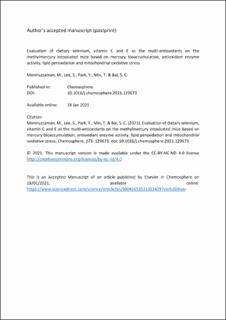Evaluation of dietary selenium, vitamin C and E as the multi-antioxidants on the methylmercury intoxicated mice based on mercury bioaccumulation, antioxidant enzyme activity, lipid peroxidation and mitochondrial oxidative stress
Peer reviewed, Journal article
Accepted version
Permanent lenke
https://hdl.handle.net/11250/2982499Utgivelsesdato
2021Metadata
Vis full innførselSamlinger
Originalversjon
Moniruzzaman, M., Lee, S., Park, Y., Min, T. & Bai, S. C. (2021). Evaluation of dietary selenium, vitamin C and E as the multi-antioxidants on the methylmercury intoxicated mice based on mercury bioaccumulation, antioxidant enzyme activity, lipid peroxidation and mitochondrial oxidative stress. Chemosphere, 273: 129673. doi: 10.1016/j.chemosphere.2021.129673Sammendrag
Mercury (Hg) in high exposures can be a potent life threatening heavy metal that bioaccumulate in aquatic food-chain mainly as organic methylmercury (MeHg). In this regard, fish and seafood consumptions could be the primary sources of MeHg exposure for human and fish-eating animals. The objective of the present study was to elucidate the effects of dietary supplementation of some antioxidants on induced mercury toxicity in mice model. In this study, a 30-day long investigation has been conducted to evaluate the dietary effect of selenium (Se) in combination with vitamin C and vitamin E on methylmercury induced toxicity in mice. Total 54 mice fed the diets with three levels of Hg (0, 50 or 500 μg kg−1) and two levels of Se in combination with vitamin C and E (Se: 0, 2 mg kg−1; vitamin C: 0, 400 mg kg−1; vitamin E: 0, 200 mg kg−1) in triplicates. The results show that Hg accumulated in blood and different tissues such as muscle, liver and kidney tissues of mice on dose dependent manner. The bioaccumulation pattern of dietary Hg, in decreasing order, kidney > liver > muscle > blood. Superoxide dismutase levels in blood serum showed no significant differences in mice fed the diets. However, dietary antioxidants significantly reduced the levels of thiobarbituric acid reactive substances in mice fed the mercury containing diets. Cytochrome c oxidase enzyme activities showed no significant differences as the mercury level increases in liver and kidney tissues of mice. Kaplan-Meier curve showed a dose- and time-dependent survivability of mice. Cumulative survival rate of Hg intoxicated mice fed the antioxidant supplemented diets were increased during the experimental period. Overall, the results showed that dietary Se, vitamin C and vitamin E had no effect on reducing the mercury bioaccumulation in tissues but reduced the serum lipid peroxidation as well as prolonged the cumulative survival rate in terms of high Hg exposures in mice.

